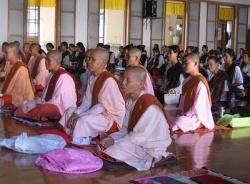Difference between revisions of "Sikkhamānā"
| Line 2: | Line 2: | ||
In [[Buddhism]], a '''[[sikkhamānā]]''' is a {{Wiki|female}} [[novice]] ([[Pali]]: ''[[Samaneri]]'') training to become a [[nun]] ([[Pali]]: ''[[Bhikkhuni]]''). In the [[Vinaya Pitaka]]'s [[Cullavagga]] X.1.4, the [[Gautama Buddha|Buddha]] prescribed that this training period is to be two years long, supervised by both a [[Monk]] and a [[nun]]. | In [[Buddhism]], a '''[[sikkhamānā]]''' is a {{Wiki|female}} [[novice]] ([[Pali]]: ''[[Samaneri]]'') training to become a [[nun]] ([[Pali]]: ''[[Bhikkhuni]]''). In the [[Vinaya Pitaka]]'s [[Cullavagga]] X.1.4, the [[Gautama Buddha|Buddha]] prescribed that this training period is to be two years long, supervised by both a [[Monk]] and a [[nun]]. | ||
| − | A young woman should be [[ordained]], according to [[Theravada]] [[tradition]], by both a [[Monk]] and a [[nun]], first as a [[Samaneri]]. Then, after a year or at the age of 20, she will be [[ordained]] as a full [[Bhikkhuni]]. The [[Theravada]] [[Vinaya]] has 311 rules of [[discipline]] for [[bhikkhunis]]. Within {{Wiki|Chinese}} {{Wiki|society}}, as an example, members of [[The Sangha]] are expected to renounce family connections and accept [[The Sangha]] as their family. | + | A young woman should be [[ordained]], according to [[Theravada]] [[tradition]], by both a [[Monk]] and a [[nun]], first as a [[Samaneri]]. Then, after a year or at the age of 20, she will be [[ordained]] as a full [[Bhikkhuni]]. The [[Theravada]] [[Vinaya]] has 311 rules of [[discipline]] for [[bhikkhunis]]. Within {{Wiki|Chinese}} {{Wiki|society}}, as an example, members of [[The Sangha]] are expected to {{Wiki|renounce}} family connections and accept [[The Sangha]] as their family. |
Thus, according to [[Vinaya Pitaka]], the [[ordination]] [[order]] for women is: [[Samaneri]] -> '''[[Sikkhamana]]''' -> [[Bhikkhuni]]. | Thus, according to [[Vinaya Pitaka]], the [[ordination]] [[order]] for women is: [[Samaneri]] -> '''[[Sikkhamana]]''' -> [[Bhikkhuni]]. | ||
Revision as of 11:54, 24 September 2013
In Buddhism, a sikkhamānā is a female novice (Pali: Samaneri) training to become a nun (Pali: Bhikkhuni). In the Vinaya Pitaka's Cullavagga X.1.4, the Buddha prescribed that this training period is to be two years long, supervised by both a Monk and a nun.
A young woman should be ordained, according to Theravada tradition, by both a Monk and a nun, first as a Samaneri. Then, after a year or at the age of 20, she will be ordained as a full Bhikkhuni. The Theravada Vinaya has 311 rules of discipline for bhikkhunis. Within Chinese society, as an example, members of The Sangha are expected to renounce family connections and accept The Sangha as their family.
Thus, according to Vinaya Pitaka, the ordination order for women is: Samaneri -> Sikkhamana -> Bhikkhuni.
